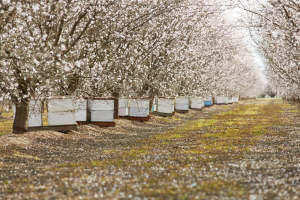Instead of writing about a pollinator plant, I want to address the weary accusation that somehow honey bees outcompete native bees and “don’t belong here” or “we can do just fine without honey bees.” Lately this controversy has gained steam despite countless research articles showing that honey bees and native bees have been getting along just fine for centuries, thank you. Truthfully, these pollinators supplement each other on our behalf. A study by Greenleaf and Kremen observed that interactions between wild bees and honey bees doubled pollination rates and enhanced the prevalence of hybrid sunflowers by five-fold.
Honey bees have been in the United States since at least 1622, but most likely since the 1500’s when Spaniards established St. Augustine, Florida – USA’s oldest city – to obtain beeswax for their candles. Recent research discovered a fossil of the honey bees’ relative Apis neararctica spp., in Stewart Valley, Nevada that dated back to the Miocene Era. So, the honey bees have been getting along with native bees for centuries!
So, what has changed? Mankind, or not-so-kind. As areas are bulldozed and stripped of woods, fields, wetlands and streams, the insects, birds and other wildlife lose places to nest, find food and shelter and exist. Pristine lawns and tidy shrubs do not provide habitat for most pollinators, let alone other wildlife. 50 million acres of perfect suburban lawns in the U.S. doesn’t help. An environmental ‘black hole’.
Honey bees are generalists with short tongues, meaning that they prefer flowers with shallow centers so that they can access the pollen and nectar easily. They like the flowers of many trees, shrubs, perennials, bulbs and annuals, including some non-native “weeds” like Japanese honeysuckle, Autumn olive and spotted knapweed. Generally, they are active on sunny days when the temperature is over 60°F, and back in the colony by evening to cool or warm the colony.
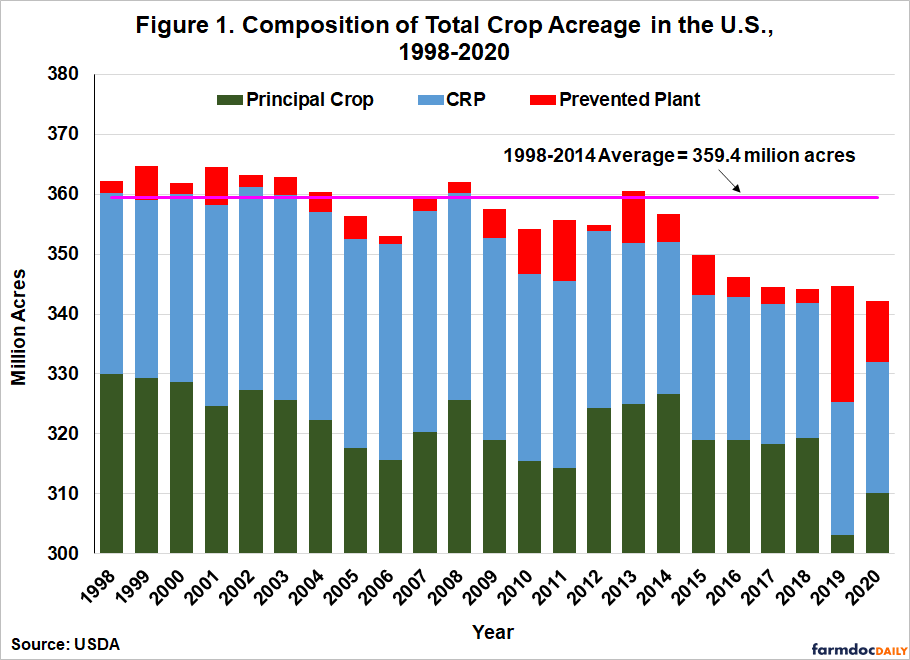
Prevented planting is a failure to plant an insured crop with the proper equipment by the final planting date designated in the insurance policy’s Special Provisions or during the late planting period, if applicable. https://farmdocdaily.illinois.edu/2021/06/estimating-total-crop-acres-in-the-us.html
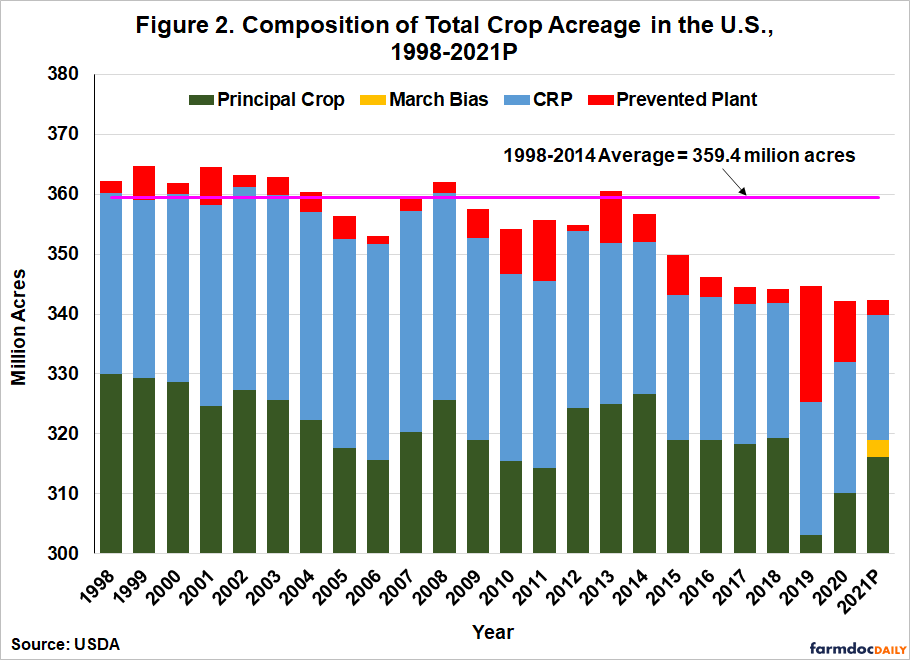 Native bees have specific preferences for plant species, for instance leafcutter bees pollinate alfalfa, canola, cranberries, onions, peas, blueberries and various other vegetables and melons. Bumble bees visit larkspur, iris, columbine, as well as tomatoes, peppers, blueberries, cranberries, broad beans and other “long throated” flowers. Several species of bumble bees are used in greenhouses, but they are expensive to order and maintain the many colonies that are needed inside these closed CEA’s (Controlled Environment Agriculture). Many native bees have long tongues and visit specific wildflowers.
Native bees have specific preferences for plant species, for instance leafcutter bees pollinate alfalfa, canola, cranberries, onions, peas, blueberries and various other vegetables and melons. Bumble bees visit larkspur, iris, columbine, as well as tomatoes, peppers, blueberries, cranberries, broad beans and other “long throated” flowers. Several species of bumble bees are used in greenhouses, but they are expensive to order and maintain the many colonies that are needed inside these closed CEA’s (Controlled Environment Agriculture). Many native bees have long tongues and visit specific wildflowers.
The squash bee is specifically designed to pollinate squash flowers but requires soft soil at the edge of the field in which to dig five to eight inch deep tunnels in which to deposit pollen and lay eggs. Although efficient at pollinating many cucurbit flowers, they only fly a quarter of a mile from their soil tunnels. If the edges of the field are treated with herbicide, plowed or mowed, the squash bees will not survive.
Mason bees are Spring time pollinators. They emerge from tubes or stems in early Spring and are mostly finished by early June. They only fly 100-300 yards from their nests. Leafcutter bees cut those curious perfectly round circles in redbud and rose leaves which they use to fold into cups to place eggs and pollen bundles into stems, holes in wood or the ground. They are active in mid-Summer (70°F) and pollinate flowers within 100 yards of their nest. Obviously, none of these bees can cover the tens of thousands of acres of orchards, fruit, vegetable and soybean fields in the United States alone.
Other pollinators such as syrphid flies, moths and beetles are far less efficient because their bodies are not hairy nor do the bodies have much contact with the pollen or stigmas. In fact, the USDA showed that the pollination services of non-Apis pollinators were valued at USD $3.44 billion, while honey bees contributed approximately $15 billion in the USA. Honey bees are responsible for pollinating over 80% of all flowering plants and 130 types of fruits and vegetables in the U.S. alone.
 Perhaps the most obvious point to the argument is that honey bees are by far the most efficient pollinator that can withstand regular management and long-distance trucking. What other insect can you pick up its nest, put it on a semi truck, drive it bouncing along for hundreds and hundreds of miles, unload it and have it still be alive, readjust to the new environment and go out and search for pollinator dependent flowers?
Perhaps the most obvious point to the argument is that honey bees are by far the most efficient pollinator that can withstand regular management and long-distance trucking. What other insect can you pick up its nest, put it on a semi truck, drive it bouncing along for hundreds and hundreds of miles, unload it and have it still be alive, readjust to the new environment and go out and search for pollinator dependent flowers?
Honey bees pollinate $20 billion worth of crops in the United States each year, including more than 130 types of fruits, nuts and vegetables. This of course, is in addition to the $3.2 million’s worth of honey produced in 2017 (USDA-National Agricultural Statistics Service (NASS)), beeswax, royal jelly, pollen and propolis that is harvested. Honey bees possess “flower fidelity” in that they will visit 50-100 apple blossoms, onion or carrot flowers or clover flowers in one trip instead of going to an apple flower then a clover then a mustard bloom, therefore the flowers visited by honey bees benefit by receiving only pollen from its cultivar or species, receiving maximum pollination. They can be placed in orchards or fields as needed to supply pollination for the entire field, then moved to meet the demands of another crop. Beehives are often important elements of urban gardens due to the pollination services they provide for backyard and community gardens, wildflowers and parks. Thanks to honey bees, birds, insects and many animals thrive on the fruits produced from the work of the honey bees.
Currently, 330 million people live in the United States with an estimated count of 400 million by 2050. Since 2000, the total area of farmland in U.S. has decreased annually. In that period, the total farmland area has decreased by almost 50 million acres, reaching a total of 893.4 million acres as of 2022. For the first time, the United States has imported more food than it has exported, meaning that we are depending upon other countries for food. In the monoculture system common in the U.S. and other advanced countries, honey bees are crucial to provide the pollination needed to feed animals and people. A study by Ritchie showed that crops are not pollinated sufficiently and that populations in many countries (including the U.S.), are undernourished due to insufficient pollination. Instead of arguing about honey bees or native bees, we should be concentrating on finding ways to keep farmland in production and provide more habitat for all pollinators.
References
https://ohioline.osu.edu/factsheet/ent-85
https://www.usda.gov/peoples-garden/pollinators/honey-bees#:~:text=Honeybees%20pollinate%20%2415%20billion%20worth,fruits%2C%20nuts%2C%20and%20vegetables
https://www.statista.com/statistics/196104/total-area-of-land-in-farms-in-the-us-since-2000/
https://www.ncbi.nlm.nih.gov/pmc/articles/PMC8396518/pdf/insects-12-00688.pdf
https://www.usda.gov/sites/default/files/documents/Attractiveness-of-Agriculture-Crops-to-Pollinating-Bees-Report-FINAL-Web-Version-Jan-3-2018.pdf
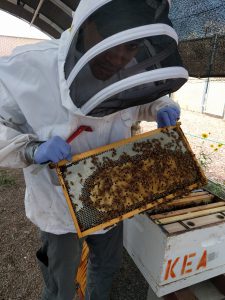
Figure 1. Duan Copeland, Ph.D., inspecting hives in Tucson, AZ.
Researchers in Tucson, Arizona, are developing an AI-powered application to simplify and automate honey bee brood disease diagnosis and promote effective disease management. Leading the charge is Dr. Duan Copeland, a postdoctoral researcher in Dr. Kirk E. Anderson’s Lab, dedicated to diagnosing brood disease using only a smartphone photograph. “What can be challenging for even master beekeepers are the subtle visual cues produced by various disease-causing agents that target honey bee larvae, including bacteria, viruses and fungi” said Copeland. “We can train an AI program to recognize these differences in the same way an expert beekeeper or apiary inspector could.”
Connecting the dots
This brood disease research was sparked by Illinois State Apiary Inspector Jim Wellwood. In 2015, Jim came to visit the Tucson lab in conjunction with the annual apiary inspectors meeting. I was intrigued by our conversation, so I began a study of brood disease sampling throughout Illinois. Using these findings as preliminary data, the Anderson lab was awarded a large NIFA grant that included disease experts and co-PIs, Dr. Jay Evans and Dr. Meghan Milbrath, titled: Using big data to improve diagnosis of larval disease in honey bees. We began this project by high-throughput sequencing the bacterial microbiomes of third, fourth and fifth instar larvae to document disease progression across six diseased and one disease-free apiary. Simultaneously, we photographed the same larvae at high resolution (https://www.nature.com/articles/s41598-023-28085-2).
Of the apiaries we selected for deep sequencing, five of seven were experiencing EFB symptoms, one was asymptomatic and one had “melty” symptoms. Our approach sampling throughout larval development showed that EFB disease can manifest in a variety of ways. Similarly, recent results sequencing the genomes of EFB causative agent, M. plutonius, indicate that different bacterial strains have radically different personalities, and differ substantially in their ability to cause disease. The behavior of M. plutonius as a larval commensal, opportunist or pathogen is defined by a collection of virulence genes that allow it to exploit larvae. Additionally, there are genes in the M. plutonius genome that confer survival in the worker gut and hive environments, including royal jelly and honey.
Surprisingly, asymptomatic larval microbiomes frequently contained M. plutonius, including those sampled from asymptomatic apiaries and colonies. Some of this result came from the Tucson Lab Apiary where we rarely, if ever, experience EFB symptoms, yet a significant proportion (41%, 31 of 75) of the healthy larval microbiomes contained M. plutonius. Similarly, at one of the Illinois apiaries with no EFB symptoms, 75% (18 of 24) of asymptomatic larvae were positive for M. plutonius. The high-throughput method used to acquire this data is more sensitive than most tests and detects small amounts of bacteria providing a more complete picture of “who” is in there versus traditional culturing methods.
We discovered a variety of bacteria that occur as relatively harmless commensals in first through third instar larvae. As demonstrated for other species, these molecular patterns serve to “train” the immune system of developing larvae. We found that the progression of European Foulbrood (EFB) differed significantly by apiary due to secondary invaders and differences in beneficial bacteria. The discovered secondary invaders were very different from those identified with earlier culture-based methods with the single exception of Enterococcus faecalis, common to all EFB diseased apiaries. In fact, the presence and abundance of E. faecalis was positively associated with that of M. plutonius across multiple apiaries especially in asymptomatic larvae. This pattern of association is consistent with culture-based results and often indicates synergy among bacterial species. This pattern wasn’t limited to E. faecalis. A number of bacteria that commonly occur throughout the honey bee social network revealed their opportunistic nature, increasing with EFB disease progression. These species were Frischella perrara, the bacterium that commonly forms a scab in the worker gut where the host waste products are excreted, Apilactobacillus kunkeei an extremophilic bacterium that specializes on honey, and Fructobacillus fructosus, a lesser honey specialist that also occurs in healthy larvae but is scarce in the adult gut.
At one of the apiaries, one colony showed symptoms of Varroosis (Parasitic mite syndrome: PMS, also known as Idiopathic Brood Disease Syndrome: IBDS). Digging a little deeper, we found that Acute Bee Paralysis Virus (ABPV) levels were extraordinarily high in the symptomatic larvae, and correlated absolutely with the “melty, deflated and sunken” symptomology recorded by the apiary inspector. Critically, all of these comprehensively defined disease states and larval stages were recorded with high-resolution digital imaging. After many weeks examining these photos and disease states, we hypothesized that larval symptoms alone could be leveraged to accurately diagnose disease.
While it is known that paralytic viruses can infect larvae, honey bee science lacks an understanding of the microbes that either cause or result from “EFB-like” brood disease, molten brood, melty larvae, Parasitic mite syndrome and Varroosis. As part of our recent NIFA grant, we have been funded to unravel this can of worms; the crud, snot brood, melty brood, and mysteries that surround EFB-like brood disease. Our approach first relied on verbal descriptors, which we quickly determined are overly subjective, and woefully inadequate for diagnosis. We instead opted for the “picture does not lie” approach. In other words, a picture is comprised of pixels of quantifiable brightness, color and hue, arranged to form emergent properties that the computer program (or your mind) has been trained to interpret as shapes, in this case larvae, healthy or diseased.
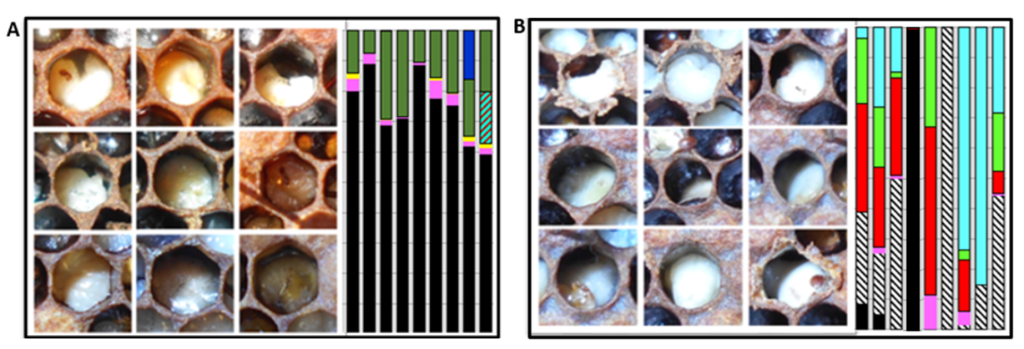
Figure 2. Images of larvae and their associated bacterial microbiomes (vertical bars) from two different apiaries with brood disease: A) Larvae infected with EFB (black) and secondary invader Fructobacillus fructosus (dark green). B) Larvae infected with Acute Bee Paralysis Virus (ABPV) and associated opportunistic bacteria that carry antibiotic resistance genes including Serratia marcescens (red) and Frischella perrara (diagonal striped). The beekeeper treated apiary “B” with antibiotics, but the treatment was ineffective.
Traditional methods used to diagnose brood disease in the field require years of expertise. Like the rest of us novice beekeepers, perhaps it required a few seasons of dedicated beekeeping to form a reliable picture of the major honey bee brood diseases; conditions like chalkbrood, sacbrood, AFB, EFB, and EFB-like. Misdiagnosis is common, and prompts the unnecessary use of antibiotics, which disrupts the balance of the honey bee’s native microbiome. In turn, this disruption promotes the emergence of antibiotic-resistant strains of bacteria, further complicating disease management. In the case of the ABPV apiary (Fig. 2), the beekeeper assumed EFB disease and applied antibiotics. As illuminated by our metagenomic analysis, the antibiotics depleted the larval microbiome of beneficial bacteria and likely contributed to ABPV disease progression by removing the native barrier to opportunistic disease.
The future with AI
By leveraging the power of AI, the team aims to minimize the risk of misdiagnosis, reduce the reliance on antibiotics and ultimately contribute to more effective disease management practices for honey bees. Artificial Intelligence has already demonstrated success in honey bee research. Examples of image-based AI include identifying subspecies by wing patterns, detecting parasitic mites, tracking pollen foraging behavior and identification of comb resources.

Figure 3. Duan Copeland evaluating the efficiency of prototype AI models.
“Even a novice could look at diseased larvae and tell you some physical characteristics about it… this one looks yellow, this one is brown, this one’s melty,” he says. “An AI program can pick up on these same patterns, but it’s crucial we have the correct diagnosis and labeling to facilitate the AI training process.” Anderson’s team is collaborating with the Bee Disease Diagnostic Service in Beltsville, Maryland and apiary inspectors around the U.S. to expand their AI image training dataset by including a wider variety of AFB, EFB, viral and fungal disease. This partnership has broadened our collection of digital images and diverse brood disease phenotypes. In addition, diseased brood samples undergo molecular diagnostic screening and microbiome analysis in Anderson’s lab to ensure the correct diagnosis. By incorporating a more comprehensive range of disease symptoms, the researchers aim to continually update and improve the AI application’s diagnostic capabilities as a honey bee health management tool. “The honey bee pathosphere is constantly evolving, so we want to keep our AI database up to date with what is being seen out there,” Copeland says.
AI in the palm of your hands
The culmination of this research will be the development of a digital product, the Big Data Brood Disease (BDBD) app. This technology will assist the broader beekeeping community by substantially increasing the probability of an accurate diagnosis when the symptoms are unclear, or when a beekeeper has little experience and has not yet formed a reliable picture of various larval disease states. Following the recent big boom in hobbyist and beginner beekeepers across the nation, our tool will significantly reduce the development of antibiotic resistance in both pathogenic, opportunistic and beneficial bacteria. The early and rapid identification of disease outbreaks will facilitate the decision to apply antibiotics or alternative approved treatments. As a result, the BDBD app will contribute significantly to healthier bee populations and more sustainable beekeeping practices. If you are dealing with larval disease outbreaks, and would like to contribute to this project, please contact the Anderson lab NIFA project manager Brendon Mott: [email protected].
By: Thomas D. Seeley
For many years, I kept on the hillside above my little house outside Ithaca, New York, a special hive of bees. This hive was mounted on a platform scale of the sort that is normally used for weighing heavy packages. I visited this hive close to dark every evening from April to October, to weigh it and see how much food (nectar and pollen) the bees living inside this hive had collected that day. On many days, flowers yielding nectar and pollen were scarce, so this scale-hive colony gathered little food and I recorded in my notebook a weight gain of just a few ounces, or maybe even a weight loss. But on some days—such as during the explosion of dandelion flowers in May, the flowering of basswood trees in July and the profusion of goldenrod flowers in September—I recorded weight gains of several pounds. Most of these big weight gains marked strong collection of nectar. On one remarkable day in September 1992, for example, my scale-hive colony had amazing success… it took in more than 27 pounds of goldenrod nectar! I estimate that when ripened into honey, the bees’ gain from this one day’s labor was about 11 pounds of honey, which is enough to fill 15 plastic squeeze bears. Days like this tell us that a colony of honey bees must cope with booms and busts in its intake of nectar. This article describes a nifty communication behavior that helps a colony do so… the tremble dance.
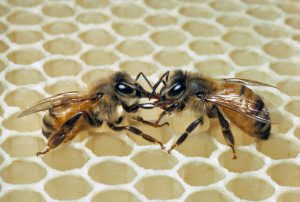
Fig 1. A nectar storer (left) has inserted her tongue between the mouthparts of a nectar collector (right). The storer bee is imbibing the nectar that the collector bee is regurgitating from the full “honey stomach” in her swollen abdomen. Photo by Kenneth Lorenzen
The acquisition of nectar involves two distinct groups of bees: (1) the bees that work outside the hive collecting nectar and (2) the bees that work inside processing nectar (Fig. 1). The members of the first group, the nectar-forager bees, are among the oldest bees in a colony while the members of the second group, the nectar-storer bees, come from the ranks of a colony’s middle-aged bees. These two groups interact in the unloading area just inside the hive entrance. This is where the nectar foragers pass off their fresh nectar to the nectar storers (Fig. 2). These bees either distribute the nectar to hungry nestmates or they store it in the honey combs for future consumption.
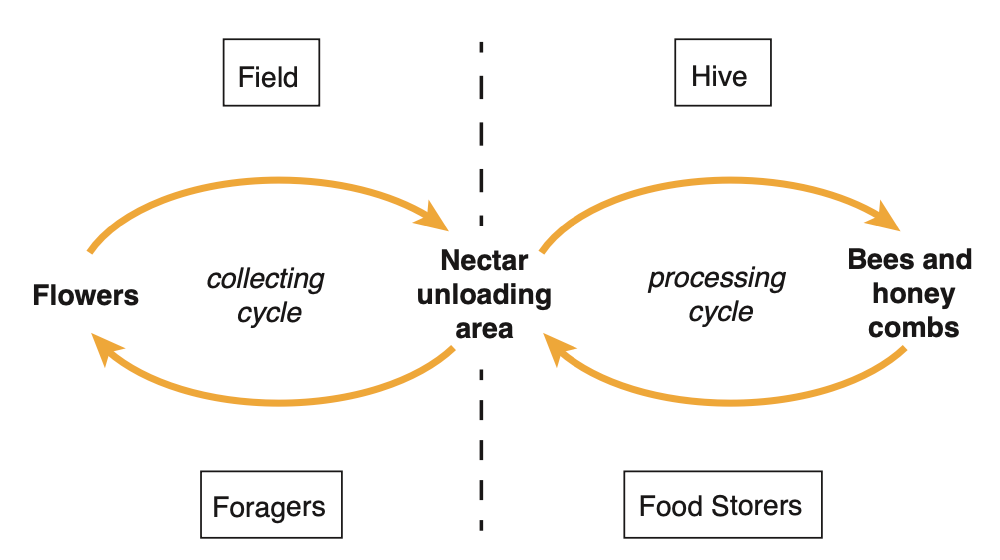
Fig 2. The division of labor between nectar foragers and nectar stores in honey bee colonies.
The specialization by worker bees on different parts of the overall task of nectar acquisition—nectar collecting and nectar processing—boosts the efficiency of a colony’s honey making. It means, for example, that when a forager has located a patch of flowers laden with nectar, she can concentrate on exploiting these flowers before they fade, competitors arrive,or darkness falls, rather than spreading her efforts between collecting work and processing work.
At the same time, however, this division of labor creates a problem of work coordination within a colony. The rates of nectar collecting and nectar processing must be kept in balance for the overall operation of nectar acquisition to proceed smoothly. If the collecting rate exceeds the processing rate, then nectar foragers will experience delays in unloading upon return to the hive. Reciprocally, if the processing rate—or more precisely, the processing capacity—exceeds the collecting rate, then the nectar storers will experience delays in finding nectar foragers who need to be unloaded. Such problems of coordination associated with division of labor are not limited to honey bee colonies. They arise in human factories as well, since the efficiency of any multistage production process depends critically upon the absence of bottlenecks in the flow of items from one stage of the process to the next.
Some years ago, as part of my studies of the organization of nectar collection by honey bee colonies, I discovered that honey bees have a special communication signal that is produced by nectar foragers and is sent to potential nectar storers, and that helps a colony to keep its rates of nectar collecting and nectar processing well matched. This discovery was an especially sweet one because it also solved a long-standing mystery that had been raised in the 1920s by the Austrian zoologist and Nobel laureate, Karl von Frisch.
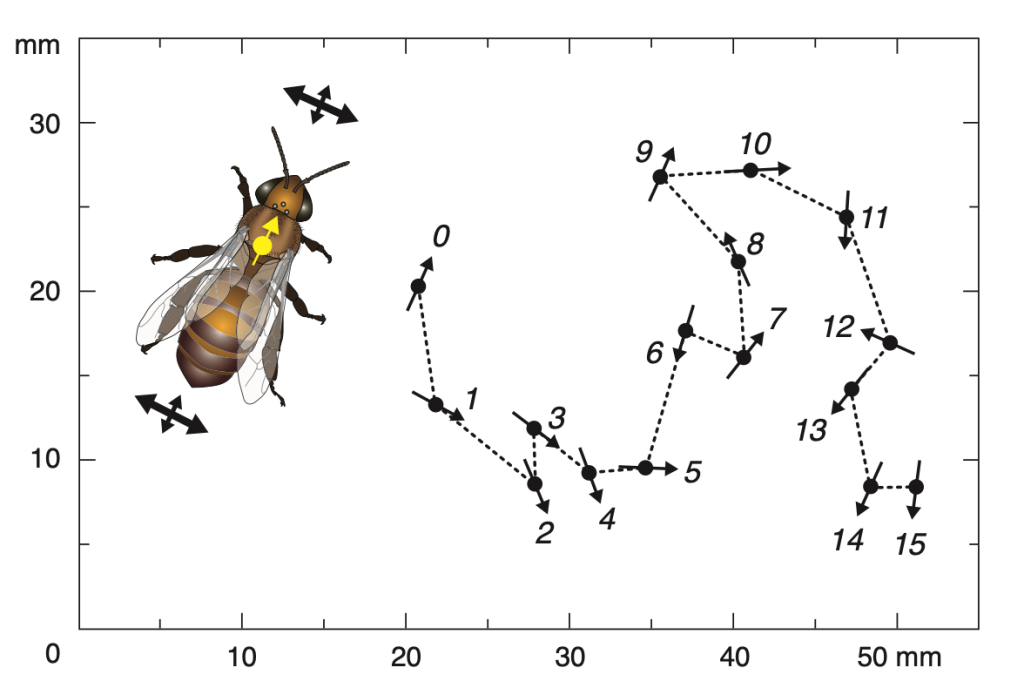
Fig 3. A 15-second record of a worker bee’s behavior while she performed the tremble dance. Drawing on left illustrates the striking, side-to-side trembles of her body. Track on right shows how this bee walked slowly across a comb and rotated her body by about 30 degrees every second or so. Scale: 50mm = 2 inches
In 1923, von Frisch published his first major report on the communication dances of honey bees. In this report, he described not only the famous waggle dance, by which foragers inform one another of the locations of rich food sources, but also a dance that he called the tremble dance (in German, der Zittertanz) (Fig. 3). My translation of his description of the tremble dance reads as follows:
At times one sees a strange behavior by bees who have returned home from a sugar water feeder or other goal. It is as if they had suddenly acquired the disease St. Vitus’s dance [chorea]. While they run about the combs in an irregular manner and with a slow tempo, their bodies, as a result of quivering movements of the legs, constantly make trembling movements forward and backward, and right and left. During this process they move about on four legs, with the forelegs, themselves trembling and shaking, held aloft approximately in the position in which a begging dog holds its forepaws. If they have brought home sugar water… often [they] will retain it until they have quieted down. The duration of this “tremble dance” is quite variable. I have seen instances where the phenomenon has died away after three to four minutes, then the bee appeared normal again and flew out of the hive. Usually, however, this dance lasts much longer and three times I have observed a bee tremble on the combs without interruption for three quarters of an hour.
The message of the tremble dance was a mystery to von Frisch, for although it seemed to be a communication signal, he was unable to identify its cause or detect any effect on other bees in the hive, despite having observed more than 60 bees perform this behavior. This led him to the tentative conclusion that the tremble dance gives the other bees no information. Some 40 years later, in his masterwork on the bees’ dances (von Frisch, 1967), he repeated this conclusion: “I think it [the tremble dance] tells the other bees nothing.” He noted that several other investigators had reported that tremble dances seemed to be the result of foragers experiencing adverse circumstances outside the hive—such as a marked deterioration of their food source—and he suggested that the tremble dance might be an incidental effect of a “nervous conflict” in these bees.
In 1987, I began to see that von Frisch’s conclusions about the tremble dance might be mistaken. I realized that this dance might play an important role in the organization of a colony’s foraging for nectar. My suspicions about this arose from some surprising results of an experiment that I performed with a colony living in an observation hive. When I removed most of the nectar storers from this colony and then observed the effects of this “surgery” on the colony’, I saw—as expected—that the nectar foragers had to search noticeably longer than usual to find nectar storers to get unloaded upon return to the hive. Their search times jumped from about 10 seconds to nearly 50 seconds. But, I also saw—to my surprise—that soon after the nectar foragers entered my observation hive and had difficulty finding nectar storers, they performed tremble dances. Wow! Furthermore, I saw that after about two hours, by which time the colony’s nectar foragers no longer needed to conduct lengthy searches to find nectar storers, the nectar foragers stopped performing tremble dances. It was clear that, somehow, the colony had replaced the nectar-storer bees that I had removed.
These serendipitous findings led me to form a two-part hypothesis regarding the tremble dance: first, its cause is nectar foragers experiencing long searches to find nectar storers; and second, its effect is to stimulate additional members of the colony to function as nectar storers. In other words, I proposed that the tremble dance serves to remove a bottleneck in the nectar acquisition process at the start of a honey flow by signaling a need for more workers to function as nectar-storer bees.
Four years later, in the Summer of 1991, I undertook an experiment designed to test my hypothesis. I moved a colony living in an observation hive to the Cranberry Lake Biological Station (CLBS), which is located in the Adirondack State Park, in northern New York. I took my study colony to this site because it is surrounded by nearly unbroken forests and lakes, so it is a place with very few flowers. Indeed, no honey bee colonies live around the CLBS, except those that I bring to it for my experiments. Here I can easily control the rate at which a colony’s nectar foragers bring nectar (sugar water) into their hive, because their only significant sources of food are the sugar-water feeders that I provide. And with the help of assistants tending the feeders, I can control the number of bees foraging at my feeders.
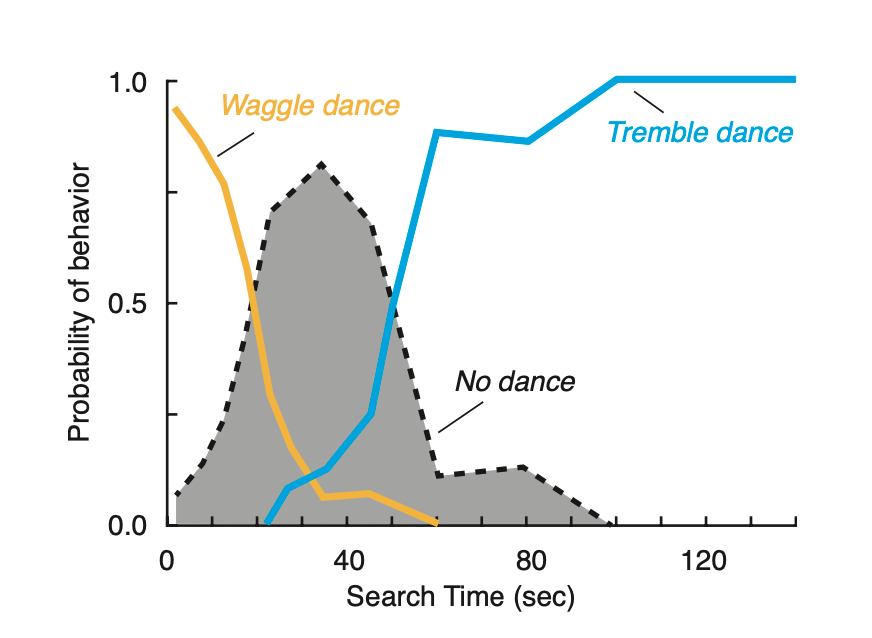
Fig 4. Dance behavior as a function of the in-hive search time for foragers that have visited a rich nectar source. Search times shorter than 20 seconds were followed by waggle dances, and search times longer than 50 seconds were followed by tremble dances.
To test my hypothesis about the cause of the tremble dance, I provided a colony living in an observation hive with two sugar-water feeders and I regulated the rate at which “nectar”-laden foragers returned to this hive by controlling the total number of bees visiting my two feeders. When this number was low (only 30 bees total), the forager bees quickly found nectar-storer bees (in just 10 seconds, on average) when they got home. And virtually all of the forager bees performed waggle dances. But when the number of bees visiting my two feeders was high (120 foragers total), these bees had difficulty finding nectar-storer bees (on average, each forager searched 45 seconds). And these forager bees no longer performed waggle dances; instead, they performed tremble dances! Overall, I saw that if a nectar forager located a nectar storer within 20 seconds of entering the hive, then she performed a waggle dance, but if she had to search for 40 seconds or more to find a nectar storer, then she performed a tremble dance (Fig. 4).
To test my hypothesis about the effect of the tremble dance, I again regulated the rate at which nectar foragers returned to the hive, but this time I counted the number of bees functioning as nectar storers on days with low and high levels of nectar-forager traffic, i.e., on days without and with tremble dancing. To count the nectar storers in my study colony, I replaced the glass on one side of my observation hive with a stiff nylon mesh (i.e., tulle, the material used to make tutus for ballet dancers) and then I daubed paint on the back of each bee that I saw unloading nectar from a forager. The effect of tremble dancing soon became clear. For example, on July 19, 1994 when the traffic level of nectar foragers was low (just three bees per minute entering the hive) and no tremble dances were performed, I labeled only 550 bees functioning as nectar storers. But on the next day, when the traffic level of nectar foragers was high (more than 25 bees per minute entering the hive) and more than 15 tremble dances were performed simultaneously within the hive, I labeled more than 1500 bees functioning as nectar storers.
These studies of the tremble dance deepened our appreciation of the complexity of the inner workings of a honey bee colony, especially of the bees’ social organization for making honey. We have long admired how foragers can share information about rich food sources by means of the waggle dance. We now understand that the effectiveness of the waggle dance in boosting a colony’s rate of nectar intake can create a problem for the bees, that of having too few nectar storers to handle the unloading needs of an enlarged group of nectar foragers. And we now understand that this problem is solved by means of a second dance produced by nectar foragers when they experience excessive delays in unloading—the tremble dance. Maybe there is even a lesson here for us. Perhaps our banks, grocery stores, and other places where customers must wait to be served should adopt a communication system like the bees’ tremble dance so that when long waiting lines develop the customers can call for additional tellers, cashiers, and the like, rather than just wait and quietly hope that more will soon appear.
Tom Seeley is a retired professor in the Department of Neurobiology and Behavior at Cornell University. This article is adapted from a chapter in his forthcoming book Piping Hot Bees and Boisterous Buzz Runners. 20 Mysteries of Honey Bee Behavior Solved. Princeton University Press.
]]>Preliminary Results from the Bee Informed Partnership
By: Nathalie Steinhauer, Mikayla Wilson, Dan Aurell, Selina Bruckner, Geoffrey Williams
Note: This is a preliminary analysis. Sample sizes and estimates are likely to change. A more detailed final report is being prepared for publication in a peer-reviewed journal at a later date. Previous years’ peer-reviewed publication can be accessed on the survey information page: https://beeinformed.org/citizen-science/loss-and-management-survey/.
The Bee Informed Partnership (http://beeinformed.org) is a non-profit organization that strives to improve honey bee colony health in the United States by performing data-driven research in collaboration with beekeepers. Its vision is to create an environment where new and established beekeepers can be successful in maintaining healthy honey bee colonies. One of the organization’s longest running programs, the national Colony Loss and Management Survey, was initiated with the support of the Apiary Inspectors of America in 2007. Since then, it has monitored colony loss rates of managed honey bees in the United States (Bruckner et al., 2023), as well as identified risk factors and protective measures associated with health, particularly as they relate to beekeeping management (Steinhauer, vanEngelsdorp and Saegerman, 2021). The survey is organized in collaboration with the Bee Lab at Auburn University (https://aub.ie/bees) and the Bee Lab at University of Maryland (https://www.umdbeelab.com/).
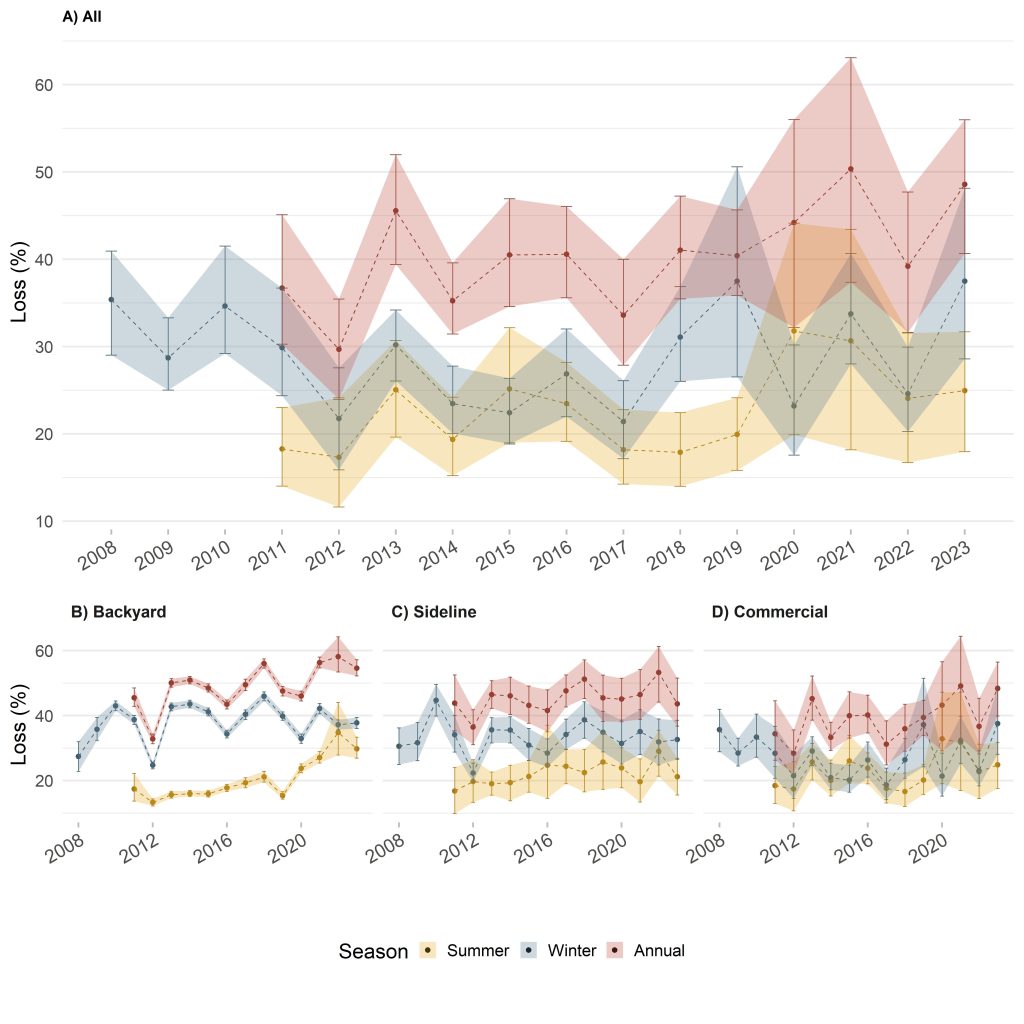
Figure 1. Seasonal managed honey bee colony loss rates in the United States across years (A), and by operation type (B-D): backyard (managing up to 50 colonies), sideline (managing 51-500), and commercial (managing >500 colonies) beekeepers. The loss rate was calculated as the total number of colonies lost divided by the number of colonies at risk during the season. Colonies at risk were composed of living colonies at the start of a period, as well as new colonies made or acquired, while excluding colonies sold or parted with. Annual loss covers the whole period from one 1 April to the next 1 April (in red); Summer (1 April – 1 October, in yellow); Winter (1 October – 1 April, in blue). Error bars represent the 95% confidence interval obtained from a bootstrap resampling of the data (n-out-of-n, 1000 rep).
The survey is a retrospective online questionnaire, which relies on voluntary participation of beekeepers across the country during the month of April. The 2023 survey covered the one year period between April 2022 and April 2023. Small scale beekeepers (1-50 colonies) and large-scale beekeepers (>50 colonies) took slightly different versions of the survey (survey question previews can be found at https://beeinformed.org/citizen-science/loss-and-management-survey/).
This year, 3,006 beekeepers from across the United States provided valid survey responses. These beekeepers collectively managed 314,360 colonies on 1 October 2022, representing 12% of the estimated 2.70 million managed honey-producing colonies in the country in 2022 (USDA NASS, 2023).
Colony loss rates were calculated as the ratio of the number of colonies lost to the number of colonies managed over a defined period. Loss rates should not be interpreted as a change in population size, but are best interpreted as a mortality rate. High levels of losses do not necessarily result in a decrease in the total number of colonies managed in the United States because beekeepers can replace lost colonies throughout the year.
During Summer 2022 (1 April 2022 – 1 October 2022), an estimated 24.9% [18.0 – 31.7, 95% bootstrapped confidence interval (CI) (Confidence intervals were obtained from the distribution of bootstrapped estimates for each group of respondents (n-out-of-n method, 1000 rep). Due to the stochastic nature of bootstrap analyses, 95% CI are expected to vary slightly at each computation.)] of managed colonies were lost in the United States (Fig. 1). This was on par with recent years. The Summer loss rate was just 1.1 percentage point (pp) higher than last year’s estimated Summer colony loss (23.8% [16.7 – 31.5 CI]), and 2.2 pp higher than the average Summer loss reported by beekeepers since the Summer of 2010 (22.6%, 12-year average), when Summer losses were first monitored.
During Winter 2022-2023 (1 October 2022 – 1 April 2023), an estimated 37.4% [28.6 – 48.1 CI] of managed colonies in the United States were lost (Fig. 1). This Winter loss rate was 13.2 pp in excess of the previous Winter loss rate (24.2% [20.3 – 29.9 CI]), and 9.1 pp higher than the average Winter loss (28.2%, 15-year average) reported by beekeepers since the start of the survey in 2008, making 2022-2023 the second highest year of Winter loss after 2018-2019 (37.7% [26.5 – 50.6 CI]). The percentage of colony loss over the Winter deemed “acceptable” by beekeepers was on average 21.3% in 2022-2023, which was on par with the previous nine years during which the acceptable loss has hovered around 20%. In 2022-2023, over 60% of the surveyed beekeepers reported Winter loss above this threshold.
Over the entire year (1 April 2022 – 1 April 2023), beekeepers in the United States lost an estimated 48.2% [40.7 – 56.0 CI] of their managed honey bee colonies (Fig. 1). This was 9.2 pp higher than last year’s estimated annual loss (39.0% [31.6 – 47.7 CI]), nearly as high as (2.6 pp lower than) the highest annual loss on record (2020-2021, 50.8% [37.4 – 63.1 CI]), and 8.5 pp higher than the average loss rate (39.6%, 12-year average) over the last 12 years.
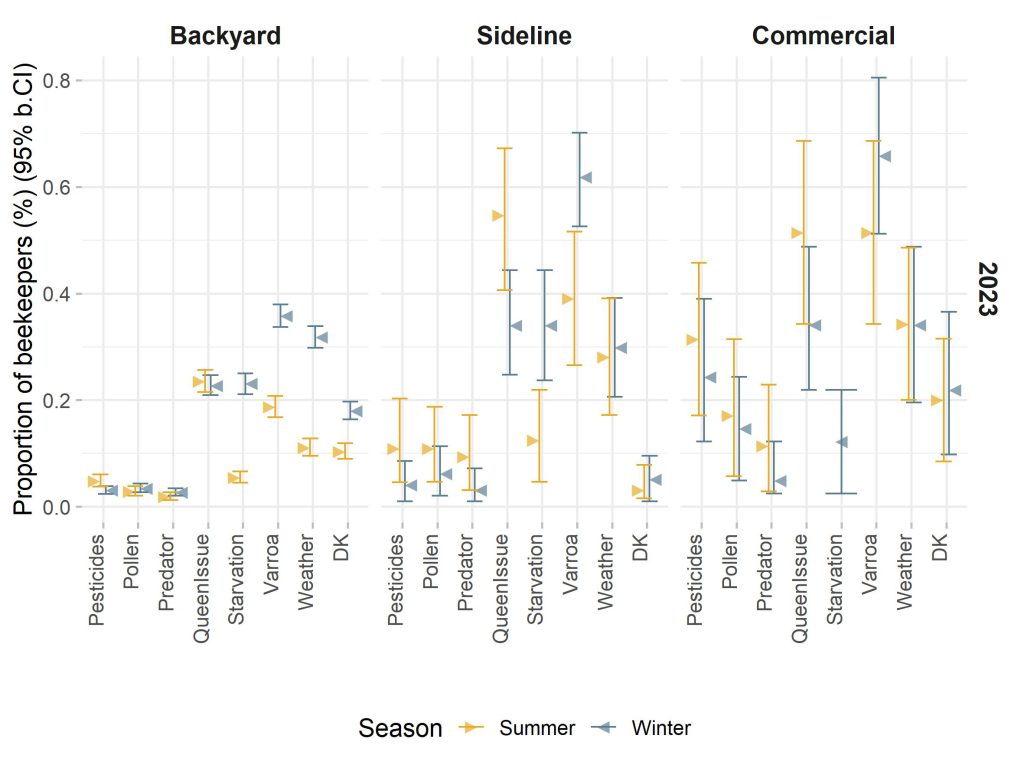
Figure 2. Self-reported causes of colony loss over Summer 2022 (1 April – 1 October, in yellow) and Winter 2022-23 (1 October – 1 April, in blue), as reported by U.S. beekeepers grouped by operation type: backyard (managing up to 50 colonies), sideline (managing 51-500), and commercial (managing >500 colonies). Number of respondents: backyard (Summer: 1,495, Winter: 2,070), sideline (Summer: 64, Winter: 97) and commercial (Summer: 35, Winter 41) beekeepers. The arrow represents the proportion of beekeepers having selected the specific cause of loss in a list of multiple choices associated with the question: “What factors do you think were the most prominent cause(s) of colony death in your operation in [season]?”. Errors bars represent the 95% confidence interval obtained from a bootstrap resampling of the data (n-out-of-n, 100 rep). Legend: Pesticides (Non-apicultural pesticides); Pollen (Nutritional stress (pollen deprivation)); Predators (e.g. bears); Queen issues; Starvation (honey/nectar/sugar water); Varroa (varroa mites and associated viruses); Weather (adverse weather (e.g. drought, cold snap)); DK (Don’t know). Answers selected by less than 10% of respondents in all three groups are not shown. Other multiple choice options not listed in the figure: Brood diseases (e.g. AFB, EFB), Natural disaster (e.g. hurricane, flood), Apicultural treatments (e.g. formic acid, amitraz), Shipping stress (e.g. overheating, truck issues). Equipment failure (e.g. moisture, ventilation), Failure of environmental controls in sheds, Scavenger pests (e.g. small hive beetle, wax moth).
As in previous years, backyard beekeepers experienced a higher annual rate of loss than commercial beekeepers in 2022-2023 (54.6% [52.2 – 57.2 CI] for backyard vs 47.9% [39.9 – 56.4 CI] for commercial). This represented a higher loss year than average for both backyard beekeepers (5.8 pp more than their 12-year average of 48.8%) and commercial beekeepers (9.7 pp more than their 12-year average of 38.2%), but it seems issues occurred at different times of the year for the two groups.
Backyard beekeepers again experienced one of their highest Summer losses on record (the last four years classified as the top four, three, one and two, respectively, in the 13-year record), with 29.8% Summer 2022 loss [26.9 – 33.4 CI], this was 10.0 pp over the previous 12-year average of 19.8%. Commercial beekeepers reported Summer losses (24.7% [17.6 – 31.7 CI]) on par (1.8 pp over) with their average over the previous 12 years (22.8%).
Though the loss rates of both groups were comparable for the Winter season (37.8% [36.0 – 39.4 CI] for backyard beekeepers, and 37.6% [28.1 – 49.1 CI] for commercial beekeepers), this represented a high loss season for the commercial group (10.7 pp over their 27.0% 15-year average), but an average season for backyard beekeepers (0.2 pp lower than their 38.0% 15-year average). Such high Winter loss rates for commercial beekeepers have only been reported once before in this survey, in 2018-2019.
The most prominent cause of colony death reported by beekeepers over the Winter 2022-23 was “varroa” (Varroa destructor, and its associated viruses), for all three operation types (Fig. 2). Backyard beekeepers then tended to cite “adverse weather” and “starvation” (meaning lack of honey, nectar, or sugar water) as the second and third most prominent causes of Winter colony loss in their operations. Sideline beekeepers equally cited “queen issues” and “starvation” as their second most prominent cause of Winter loss. Commercial beekeepers cited equally “queen issues” and “adverse weather”.
In the Summer of 2022, the most prominent cause of colony death reported by beekeepers of all operation types was “queen issues” (Fig. 2). Both backyard and sideline beekeepers then listed “varroa” and “adverse weather”. Commercial beekeepers cited “varroa” as frequently as “queen issues” as their most prominent causes of loss over the Summer, followed by “adverse weather”.
Although the total number of honey bee colonies in the country has remained relatively stable over the last 20 years (~2.6 million colonies according to the USDA NASS Honey Reports), loss rates remain high, indicating that beekeepers are under substantial pressure to recover from losses by creating new colonies every year. The Bee Informed Partnership’s annual Colony Loss and Management Survey offers an important record of such loss rates experienced by beekeepers across the United States each year. Until the survey was launched in 2007, there was no rigorous record of loss rates of managed honey bee colonies, making it difficult to compare losses against historic levels.
To obtain more information about Bee Informed Partnership’s annual national Colony Loss and Management Survey, visit: https://beeinformed.org/citizen-science/loss-and-management-survey/.
State level estimates, including estimates for single-state and multi-state operations, will be published on https://research.beeinformed.org/loss-map/.
Authors
Nathalie Steinhauer – Department of Entomology, University of Maryland, College Park, MD, USA and Bee Informed Partnership, College Park, MD, USA
Mikayla Wilson – Department of Entomology, University of Maryland, College Park, MD, USA and Bee Informed Partnership, College Park, MD, USA
Dan Aurell – Department of Entomology & Plant Pathology, Auburn University, Auburn, AL, USA
Selina Bruckner – Department of Entomology & Plant Pathology, Auburn University, Auburn, AL, USA
Geoffrey Williams – Department of Entomology & Plant Pathology, Auburn University, Auburn, AL, USA
Corresponding authors: [email protected] (NS) & [email protected] (GW)
References cited
Bruckner, S., Wilson, M., Aurell, D., Rennich, K., vanEngelsdorp, D., Steinhauer, N. and Williams, G.R. (2023) ‘A national survey of managed honey bee colony losses in the USA: results from the Bee Informed Partnership for 2017–18, 2018–19, and 2019–20’, Journal of Apicultural Research, 62(3), pp. 429–443. Available at: https://doi.org/10.1080/00218839.2022.2158586.
Steinhauer, N., vanEngelsdorp, D. and Saegerman, C. (2021) ‘Prioritizing changes in management practices associated with reduced winter honey bee colony losses for US beekeepers’, Science of The Total Environment, 753, p. 141629. doi: https://doi.org/10.1016/j.scitotenv.2020.141629
USDA NASS (2023) Honey (March 2023). ISSN: 1949-1492. Available at: https://usda.library.cornell.edu/concern/publications/fq977t78v?locale=es (Accessed 16 June 2023).
Previous survey results
Aurell, D., Bruckner, S., Wilson, M., Steinhauer, N., Williams, G., for the Bee Informed Partnership (2022). United States Honey Bee Colony Losses 2021-2022: Preliminary Results. https://beeinformed.org/2022/07/27/united-states-honey-bee-colony-losses-2021-2022-preliminary-results-from-the-bee-informed-partnership/ (Accessed 16 June 2023).
Steinhauer, N., Aurell, D., Bruckner, S., Wilson, M., Rennich, K., vanEngelsdorp, D., Williams, G., for the Bee Informed Partnership (2021). United States Honey Bee Colony Losses 2020-2021: Preliminary Results. https://beeinformed.org/wp-content/uploads/2021/06/BIP_2020_21_Losses_Abstract_2021.06.14_FINAL_R1.pdf (Accessed 16 June 2023).
Kulhanek, K., Steinhauer, N., Rennich, K., Caron, D. M., Sagili, R. R., Pettis, J. S., Ellis, J. D., Wilson, M. E., Wilkes, J. T., Tarpy, D. R., Rose, R., Lee, K., Rangel, J. and vanEngelsdorp, D. (2017) ‘A national survey of managed honey bee 2015–2016 annual colony losses in the USA’, Journal of Apicultural Research, 56(4), pp. 328–340. https://www.tandfonline.com/doi/full/10.1080/00218839.2017.1344496.
Lee, K. V., Steinhauer, N., Rennich, K., Wilson, M. E., Tarpy, D. R., Caron, D. M., Rose, R., Delaplane, K. S., Baylis, K., Lengerich, E. J., Pettis, J., Skinner, J. A., Wilkes, J. T., Sagili, R., vanEngelsdorp, D. and Partnership, for the B. I. (2015) ‘A national survey of managed honey bee 2013–2014 annual colony losses in the USA’, Apidologie, pp. 1–14. https://link.springer.com/article/10.1007/s13592-015-0356-z.
Seitz, N., Traynor, K. S., Steinhauer, N., Rennich, K., Wilson, M. E., Ellis, J. D., Rose, R., Tarpy, D. R., Sagili, R. R., Caron, D. M., Delaplane, K. S., Rangel, J., Lee, K., Baylis, K., Wilkes, J. T., Skinner, J. A., Pettis, J. S. and vanEngelsdorp, D. (2015) ‘A national survey of managed honey bee 2014–2015 annual colony losses in the USA’, Journal of Apicultural Research, 54(4), pp. 292–304. https://www.tandfonline.com/doi/full/10.1080/00218839.2016.1153294.
Spleen, A. M., Lengerich, E. J., Rennich, K., Caron, D., Rose, R., Pettis, J. S., Henson, M., Wilkes, J. T., Wilson, M., Stitzinger, J., Lee, K., Andree, M., Snyder, R., vanEngelsdorp, D., and for the Bee Informed Partnership (2013) ‘A national survey of managed honey bee 2011–12 winter colony losses in the United States: results from the Bee Informed Partnership’, Journal of Apicultural Research, 52(2), pp. 44–53. https://www.tandfonline.com/doi/abs/10.3896/IBRA.1.52.2.07.
Steinhauer, N. A., Rennich, K., Wilson, M. E., Caron, D. M., Lengerich, E. J., Pettis, J. S., Rose, R., Skinner, J. A., Tarpy, D. R., Wilkes, J. T. and vanEngelsdorp, D. (2014) ‘A national survey of managed honey bee 2012-2013 annual colony losses in the USA: results from the Bee Informed Partnership’, Journal of Apicultural Research, 53(1), pp. 1–18. https://www.tandfonline.com/doi/abs/10.3896/IBRA.1.53.1.01.
vanEngelsdorp, D., Caron, D., Hayes, J., Underwood, R., Henson, M., Rennich, K., Spleen, A., Andree, M., Snyder, R., Lee, K., Roccasecca, K., Wilson, M., Wilkes, J., Lengerich, E. and Pettis, J. (2012) ‘A national survey of managed honey bee 2010-11 winter colony losses in the USA: results from the Bee Informed Partnership’, Journal of Apicultural Research, 51(1), pp. 115–124. https://www.tandfonline.com/doi/abs/10.3896/IBRA.1.51.1.14.
vanEngelsdorp, D., Hayes, J., Underwood, R. M., Caron, D. and Pettis, J. (2011) ‘A survey of managed honey bee colony losses in the USA, fall 2009 to winter 2010’, Journal of Apicultural Research, 50(1), pp. 1–10. https://www.tandfonline.com/doi/abs/10.3896/IBRA.1.50.1.01.
vanEngelsdorp, D., Hayes, J., Underwood, R. M. and Pettis, J. (2008) ‘A Survey of Honey Bee Colony Losses in the U.S., Fall 2007 to Spring 2008’, PLoS ONE, 3(12). https://journals.plos.org/plosone/article?id=10.1371/journal.pone.0004071.
vanEngelsdorp, D., Hayes, J., Underwood, R. M. and Pettis, J. S. (2010) ‘A survey of honey bee colony losses in the United States, fall 2008 to spring 2009’, Journal of Apicultural Research, 49(1), pp. 7–14. https://www.tandfonline.com/doi/abs/10.3896/IBRA.1.49.1.03.
vanEngelsdorp, D., Underwood, R., Caron, D. and Hayes, J. (2007) ‘An estimate of managed colony losses in the winter of 2006-2007: A report commissioned by the apiary inspectors of America’, American Bee Journal, 147(7), pp. 599–603.
]]>Click Here if you listened. We’re trying to gauge interest so only one question is required; however, there is a spot for feedback!
Read along below!
Found in Translation
Gut Microbes Help Bees Survive the Season
By: Jay Evans, USDA Beltsville Bee Lab
It will surprise most Bee Culture readers that microbes come in flavors that can be good, bad or indifferent to the health of their honey bee hosts. As we approach Fall, it is tempting to focus on the microbes on the good side and try to find out how to feed them for bee health prior to Winter. As someone who studies honey bee disease, I can’t help but focus on the good microbes that might interfere with agents of harm lurking in our beehives.
Kirk Anderson and colleagues in the USDA’s Tucson Carl Hayden Bee Research Laboratory have been exploring the impacts of gut microbes on bee health for a decade now. In past work, they showed how these microbes are beneficial in the guts of bees but generally ‘don’t’ help in the processing of pollen stored as bee bread. They have also shown how queens and workers differ greatly in the microbes they harbor and the impacts of bee contact on moving microbes around (see Anderson’s ‘Google Scholar’ profile for lists of his papers on these topics; https://scholar.google.com/citations?user=JiEFFkIAAAAJ&hl=en&oi=ao).
They have also explored how bees suffer mortality when the delicate microbial balance is upset. Recently, they have investigated honey bee overwintering, testing for the right mixes of nutrition and temperature that improve the odds of colony survival (hint: cold is good, to a certain degree). In a paper this past year, they describe how the gut microbes of bees react before and during Winter, building the case that microbes are critical for overwintering success (Anderson, K.E.; Maes, P. Social microbiota and social gland gene expression of worker honey bees by age and climate. Scientific Reports 2022, 12, 10690, doi:10.1038/s41598-022-14442-0).
They also show that the overwintering environment can favor certain microbes that are less helpful for bee health. Specifically, bee colonies overwintered in a warm environment started with the typical population of gut bacteria but that population broke bad in the end, notably thanks to overgrowth (these were NOT found in bees) as well as several types which ARE known to decrease bee health. Just what it is about warmer Winter environments that favors an odd, and apparently harmful, bacterial group is not known, and solving this will be key in future work aimed at prepping bees for current or future Winter climates.
More generally, disease agents are opportunists; taking advantage of their victims when something else is out of whack. These opportunities can arise from stressors in the environment, poor genetics or inadequate nutrition. Opportunities might also arise when populations of good bacteria are somehow absent. There are a myriad of ways that such ‘good’ microbes could help bees in the face of disease, from providing a physical layer on the gut wall that frustrates pathogens, to improving nutrient transfer or stimulating bee immunity.
Finally, gut microbes might directly attack the bad actors. Studies showing increased honey bee disease following heavy antibiotic treatments provide ample evidence for the roles of natural bee bacteria. In one such study, led by Jiang Hong Li and my USDA colleague Judy Chen (Li, J.H.; Evans, J.D.; Li, W.F.; Zhao, Y.Z.; DeGrandi-Hoffman, G.; Huang, S.K.; Li, Z.G.; Hamilton, M.; Chen, Y.P. New evidence showing that the destruction of gut bacteria by antibiotic treatment could increase the honey bee’s vulnerability to Nosema infection. PloS one 2017, 12, e0187505, doi:10.1371/journal.pone.0187505). Gut microbes were shown to help bees resist nosema disease. A cleansing of gut bacteria by an intensive antibiotic regime resulted in shorter lifespans overall, and increased the impacts of nosema exposure on longevity.
Sean Leonard and colleagues, in the University of Texas laboratory of Nancy Moran, showed that a human assist can further sharpen the impacts of natural gut microbes on bee parasites. Specifically, they engineered (in the laboratory) a common ‘good’ bacterium of bees so that it targeted challenges as distinct as Varroa mites and Deformed wing virus (Leonard, S.P.; Powell, J.E.; Perutka, J.; Geng, P.; Heckmann, L.C.; Horak, R.D.; Davies, B.W.; Ellington, A.D.; Barrick, J.E.; Moran, N.A. Engineered symbionts activate honey bee immunity and limit pathogens. Science 2020, 367, 573-576, doi:10.1126/science.aax9039).
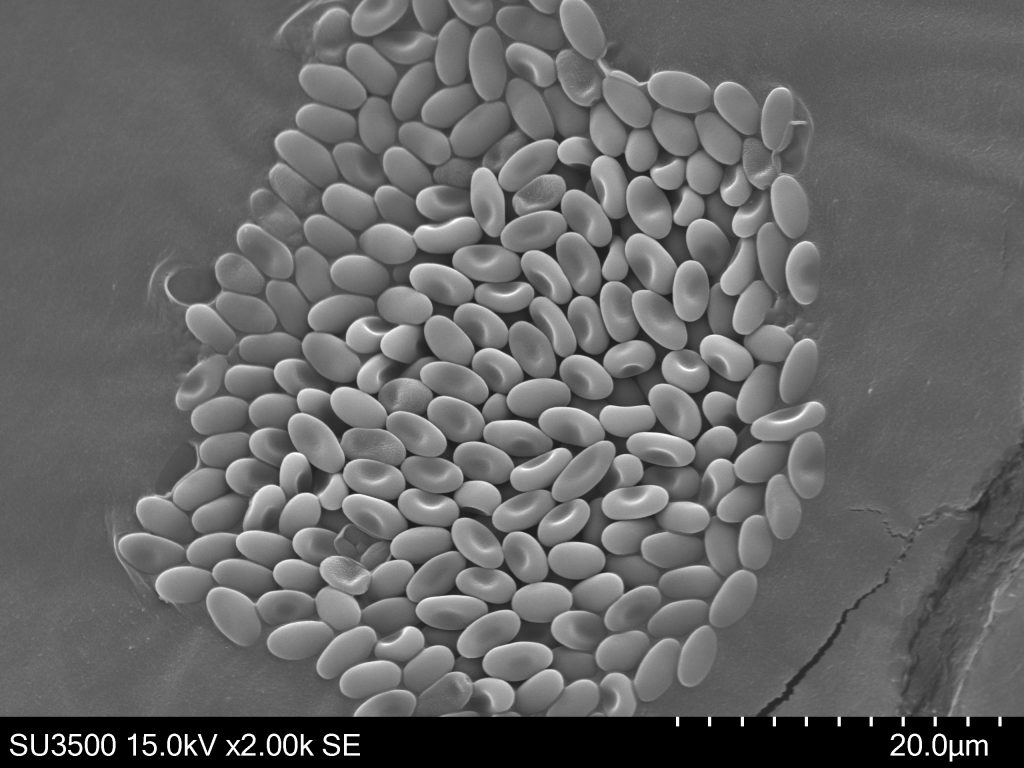
Nosema. Credit: Qiang Huang
Work this year based on the same strategy (led by Qiang Huang from Jiangxi University, working in Moran’s lab) showed resident bacteria could be altered to successfully target nosema disease (Huang, Q.; Lariviere, P.J.; Powell, J.E.; Moran, N.A. Engineered gut symbiont inhibits microsporidian parasite and improves honey bee survival. Proceedings of the National Academy of Sciences 2023, 120, e2220922120, doi:10.1073/pnas.2220922120). Bees with the engineered bacteria both lived significantly longer and had far fewer nosema spores to pass on to their nestmates. Interestingly, bees fed the gut bacterium alone, and the bacterium with a nonspecific (not targeting nosema), modification also showed signs of reducing disease impacts, supporting the evidence that the bacterium itself is also a friend to bees.
Short of this high-tech solution, are there ways that beekeepers can help nurture the natural gut bacteria found in their beehives? If you supplement your bees, a recent paper by Elijah Powell and others in Moran’s group suggests that pollen-based supplements tend to lead to a more balanced ‘core’ set of bacteria in the bee gut, possibly decreasing the threats from at least one bacterial pathogen of adult bees (Powell JE, Lau P, Rangel J, Arnott R, De Jong T, Moran NA (2023) The microbiome and gene expression of honey bee workers are affected by a diet containing pollen substitutes. PLoS ONE 18(5): e0286070. https://doi.org/10.1371/journal.pone.0286070). I know there are many colony supplements available and I don’t claim this makes a pollen-based supplement better for bees overall than supplements with a different protein source (nor, of course, does this represent any formal endorsement of one type of bee feed over another). Still, it is interesting to contemplate how particular supplements affect not just bees but the hitchhiking microbes that have adapted to life in their guts.
One thing is clear from these diverse studies. While many of us focus on the microbes whose effects are damaging to bee colonies, most hive microbes are neutral or even beneficial to their bee hosts in Summer and Winter. Bees have been harnessing this power for millennia, and we would do well to help them sustain the right mix of gut partners.
]]>Click Here if you listened. We’re trying to gauge interest so only one question is required; however, there is a spot for feedback!
Read along below!
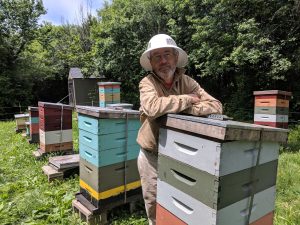
Beekeeping
A Path to Some Economic Freedom
By: Ross Conrad
The economic upheaval of the recent COVID years has revealed weaknesses in our economic system and many of the unsung benefits we beekeepers can enjoy from practicing our craft. We saw what’s been called the “Great Resignation” where workers left their jobs in droves. One of the primary reasons employees quit was due to the way employers treated them. For others, it was the company culture and values that did not align with their own. For those stuck in dead-end jobs, the COVID Economic Impact Payments provided the financial buffer they needed to transition into a new working situation. The dramatic decrease in unemployment made it challenging for employers to hire help, but made it much easier for workers to leave lousy jobs. The ruling and economic elite hate low unemployment because then workers have options and it makes it too easy for them to leave their jobs for a better one. This also puts upward pressure on wages which decreases profits. Far too many employers rely on the Federal Reserve’s efforts to manipulate interest rates and keep living expenses high enough so people’s savings will get used up and there will be plenty of desperate workers willing to accept jobs that they normally would not take. The Fed also works to keep unemployment high enough so most workers would not dare to leave their jobs, no matter how bad they are, because there are lots of financially hurting people waiting in the wings to take their place and there is so much competition for work that getting a better job is difficult.
Higher interest rates put the brakes on the housing market but apparently too many consumers still flush with cash saved up during the pandemic continue to spend. When discussing the Fed’s increases in interest rates on the November 2, 2022 airing of National Public Radio’s Morning Edition, the President of the Federal Reserve Bank of Kansas City, Esther George, stated, “We see that there is a bit of a savings buffer still sitting for households, that may allow them to continue to spend in a way that keeps demand strong,” she said. “That suggests we may have to keep at this for a while.”
NPR’s Morning Edition also interviewed Federal Reserve Chair Jerome Powell who stated: “No one knows whether there’s going to be a recession or not, and if so, how bad that recession would be… Our job is to restore price stability so that we can have a strong labor market that benefits all, over time.” Of course, Powell’s idea of a strong labor market is one where there are lots of people out of work so that employers have no problem finding workers for jobs that offer poor pay and few-to-no benefits. The “all” that benefit from the price stability of more people out of work due to higher interest rates is the business class, not the majority of the people who work for a living.
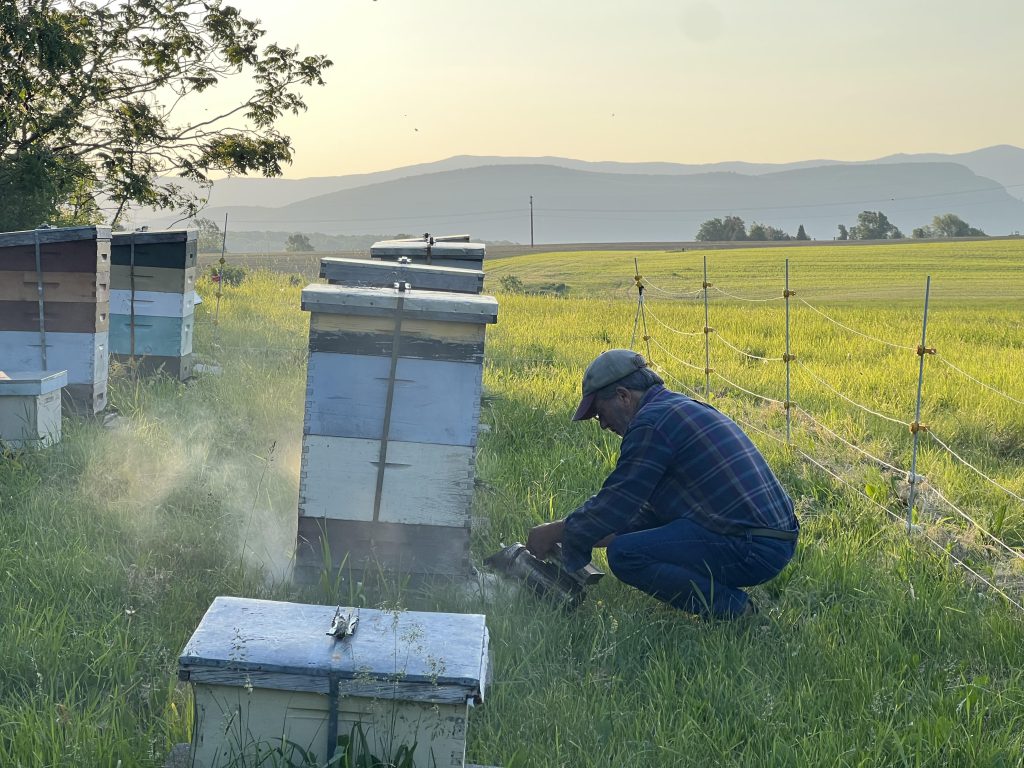
While most beekeepers are backyard part-timers with a few hives, a small percentage of beekeepers make a part-time, or full-time, business of beekeeping, and it is these beekeepers that account for the majority of managed honey bee colonies.
In honey bee economics, each individual bee’s efforts are primarily aimed at supporting the common good of the whole. No worker tries to monopolize hive resources and control or restrict access to the rest of the colony for their own personal gain. With a few notable exceptions, most of human culture that’s dedicated to the capitalist economic system works in the opposite way of a honey bee colony. Greed is promoted and rewarded. Monopolization, consolidation of power and control of the market is the goal, and employees are seen as an expense that should be minimized as much as possible, and are too often considered disposable. Unskilled laborers in particular are treated with little respect and dignity.
Of course no employee ever gets paid what they’re actually worth. The system is designed so that a company must purchase your labor wholesale so they can sell it retail. We have all been well indoctrinated into accepting this situation as the natural order of things but it took a long time to get us to this point. The first factories to open up and hired unskilled laborers at the dawn of the industrial age were greeted with strong opposition and protests from the populace. Rather than a person using a skilled craft to produce something useful that they could then sell or barter, individuals traded their time for money doing jobs that most anyone could do with a little training. Folks back then saw this for what it was, treating people with disrespect and compromising their independence and dignity.
People believed there was little difference between being a factory worker and a slave. Of course the factory worker’s situation is supposed to be voluntary and temporary since they can choose to quit at any time. Unlike a slave that the slave owner has to house, feed and clothe, the factory worker is expected to use their meager earnings to purchase their own accommodations and necessities and hope there is enough left over for a little discretionary spending.
To prevent employees from scrimping and saving so they can afford to eventually leave their jobs, companies took a page from indentured servitude farmers and establish company stores to provide their employees with goods, and built lodging to rent to workers, all at rates designed to ensure they could never afford to leave.
There are those who argue that working for others provides great benefits such as a reliable working situation, a greater sense of one’s basic needs being provided for which can instill a sense of personal security and stability, and not having to take the financial risks of running your own business. While this is all true, much of the same can also be said of slavery.
As far back as 44 BC, Cicero is quoted as saying “vulgar are the means of livelihood of all hired workmen whom we pay for mere manual labor, not for artistic skill; for in their case the very wage they receive is a pledge of their slavery.”
When Fredrick Douglass took a paying job, he is reported to have declared “Now I am my own master.” After life as a slave, receiving a wage that you can decide how to spend can feel like you have some level of freedom. Only later did he realize to the contrary, “experience demonstrates that there may be a slavery of wages only a little less galling and crushing in its effects than chattel slavery, and that this slavery of wages must go down with the other.”
Through a craft like beekeeping, one has the opportunity to escape wage slavery, choose their own hours and make their own decisions. Sure they take on all financial risks, but they also get to enjoy all the financial benefits. Beekeepers may not become millionaires from their efforts, but there is immense satisfaction that comes from being your own boss and living the agrarian lifestyle.
We have become well indoctrinated into maintaining capitalism and identifying with it as our means of survival for so long, that the idea of people working together, rather than competitively, to meet their collective needs like in the example of the bee hive, seems improbable if not impossible. What would we get in return for our selfless efforts to help maintain each other’s existence?
One well established economic model inspired by bees and the rest of the natural world comes in the form of the cooperative business. Work that is not based upon individual craft work can be organized by worker self-management. An example is Sioux Bee Honey, a beekeeper owned co-operative that notes on its website: “One bee can’t do it all, neither can one farmer. It’s why five humble beekeepers from Sioux City, Iowa, formed a co-op to share equipment and resources to bring more honey to market. It’s a way of doing business where family farms stay in the family and decisions are made democratically.”
Like all farming, beekeeping provides the foundation for a strong and resilient economy by creating new human centric wealth from the communal wealth of the natural world. Almost all other businesses and economic activities simply reorganize human centric wealth that already exists in order to extract more wealth, but farming in general and beekeeping specifically, combine sun, air, water and earth with the efforts of a bee colony to create new wealth (e.g. honey, beeswax, etc.) that did not previously exist. This is why agricultural revolutions must come before industrial or economic revolutions.
Beekeeping provides self-employment and all the social and economic benefits that go with it. The greatest advantage is throwing off the yoke of wage slave employment in our increasingly volatile economy and not being subject to the whims of “at will” employers. You also get to write-off legitimate beekeeping expenses on your tax return, reducing your tax bill so you get to keep more of your hard-earned money.
Beekeeping also appears to be somewhat technologically future-proof. The nature of beekeeping work suggests that despite current efforts to replace humans with robots and artificial intelligence in many areas of the economy, beekeeping is unlikely to ever become fully automated. There is a long list of technological promises like the paperless office that computers were supposed to create, less toxic pesticide use thanks to genetically engineered organisms, and electricity from nuclear power plants that is too cheap to meter, all of which never came to fruition. Sure there are sensors and gadgets we can use to monitor hives and provide real-time data on colonies, but a human being knowledgeable in honey bee management, biology, pests and pathogens, along with a working knowledge of meteorology and apiary goal considerations will still be needed to analyze the data and determine the best course of action to take, as well as carry out the necessary physical hive manipulations in the field.
When planned accordingly, beekeepers have a better chance of avoiding on-the-job burnout by freeing up some of their time, since unlike other farm and domesticated animals; bees do not need daily attention. Of course a beekeeper can keep so many colonies that they end up working seven-days-a-week, but a beekeeper can enhance their time flexibility by choosing to keep the number of colonies down to a manageable amount that can be worked within whatever number of days a week the beekeeper wants to work on a regular basis.
A little bit of economic freedom, allows you to make choices. We, who live in the highly developed countries of today, have choices unparalleled in the history of mankind. We can chase after money and be incredibly wealthy, get an amazing education, choose to be lazy, or try to make the world a better place. We have many choices but to exercise those choices it helps a lot to have some economic freedom. Beekeeping is one way to provide some of that freedom.
Ross Conrad is the author of Natural Beekeeping, Revised and Expanded 2nd edition, and The Land of Milk and Honey: A history of beekeeping in Vermont.
]]>Click Here if you listened. We’re trying to gauge interest so only one question is required; however, there is a spot for feedback!
Read along below!
 Keeping Beeyards on Trailers
Keeping Beeyards on Trailers
“Mobile Beeyards”
By: James E. Tew

Figure 1. Jeff Ott, Beekeeper, Podcaster and conversationalist.
Trailering Bees
I recently chatted with Jeff Ott, an experienced beekeeper about trailering bees (Edited comments taken from “Bee Trailers – The Portable Bee Hive” podcast, Honey Bee Obscura, May 18, 2023. Podcast #126. https://www.honeybeeobscura.com/bee-trailers-the-portable-bee-hive-126/). I recorded the conversation and transcribed it for you.
Jim: I must have five trailers right now, and before anybody says, “Oh, my stars!” you should know that they’re all small. I’ve got anywhere from really small trailers that go behind my small tractors all the way up to two bigger trailers that I can tow behind my truck.
At one time or another I have had bee colonies on every one of those trailers. It’s been my experience, as an older beekeeper, that I want wheels or rollers on everything in my bee life.
When moving hives for pollination, even as a younger man, I was eager to use trailers. Is there any way that I can use a trailer and not have to take these colonies off this truck, set them down, go back eight to 10 days later, and do the whole thing over again? It’s a vast amount of work to load and unload hives.
An immediate question for the grower is, “Can I just put these hives on a trailer and then unhook it and be gone?” Many times, the growers would stand their ground and require me to set colonies throughout the orchard. That was a lot more work and it is easier to lose a colony in tall grass.
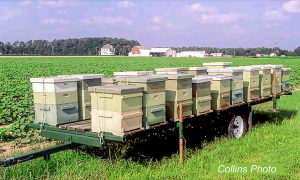
Figure 2. A commercial beekeepers’ trailered hives for pollinating cucumbers.
Jeff: The big guys, have their front-end loaders and pallets and they’re all set to do this kind of in-and-out type of beekeeping and pollination or whatever you’re doing. All the while, moving from one location to another while following the bloom, so to speak. Smaller beekeeping operations can’t afford the front-end loaders or skid loaders, and the trailer becomes a viable option. There’s a lot to consider when you’re looking at a trailer for hauling bees.
Jim: Right off the bat. You almost said it, I was waiting for it – right off the bat, “Why would I use a trailer of any size?” My immediate response is because they are generally much lower to the ground than my pickup or a larger truck. I don’t have to pick the colony up or lift the colony as high off the ground.
Yes, I can use ramps on the tailgate of the truck, but do you want someone to make pictures of you when you’re trying to pull that beehive up those ramps – backwards – into the truck? That foot and a half or so height difference really matters. If you got the right trailer, it may actually have loading ramps that are built on the back of it.
Jeff: Yes.
Jim: I find it much easier to load a trailer with bees than I do to get them up in my truck or, in the old days, on a flatbed truck, and then get them back off.
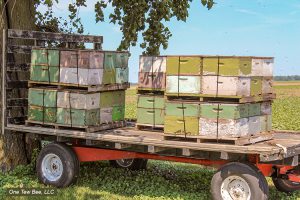
Figure 3. A hybrid-looking system using a front-end loader to set hives from the truck onto a farm wagon for distribution around the planting.
Jeff: No, it only takes once or twice of trying to load a heavy beehive into a back of a pickup truck before you realize this won’t work as a regular event. It’s good for once or twice when moving a beeyard. If you’re doing on a regular basis, the trailer really comes in handy and the lower to the ground – within limits – the better.
You have to take into consideration where your beeyards are located. If you’re doing pollination contracts or following the bloom, then you have to consider ground clearances. That becomes a whole different factor in trying to decide what trailer you want.
Jim: If you’re going to unhitch the trailer and then back it up again, yes, the beekeeper wants to know if the yard is level. Is the yard solid? In a perfect bee world, the sky is always blue, birds are always singing, and bees are always happy, but the common reality is that it’s 2:30 in the morning, the dew has fallen, the truck’s slipping on the grass, and you can’t see the hitch. You’ve got no one to help you because you’ve got no friends, Jeff. You’ve already been through all of them years ago. The devil is in the details.
Jeff: The only friends you have at that time is mosquitoes. They’re all over you.
Jim: [laughs] They’re not friends. They’re just there at the same time. I do want to put this in our discussion right now. If you haven’t done it, you are probably going to do it.
Here’s the situation. If you’ve got a smallish, single axle trailer, you listened to a podcast or you read an article somewhere, and you bought a trailer. Now it’s time to return and hitch it back to the truck. When that trailer is not hitched to the truck and the hives are not situated right over the axle, or even better, nearer the front of the trailer, the tongue will fly up in the air because you suddenly put your body weight on the back of the trailer. The axle, serving as a fulcrum, with the hives in the center, will tilt up. Suddenly, you’ve abruptly got your bees unloaded. They’ll come sliding down that trailer towards you. So, hitch the trailer to the truck first. Then work with the colonies. All those years ago, that brings me to the very next point, if possible, that the towing vehicle should be a four-wheel drive vehicle.
Jeff: Your towing vehicle?
Jim: Yes, your towing vehicle should be four-wheel drive. Like I said, the world’s not always perfect. Sometimes it’s rainy and muddy. You’ve mentioned pollination work. In fact, I’ve moved hives most of the time not for pollination work, but for management reasons.
For instance, I had a couple of hives that wouldn’t stop stinging the whole neighborhood. The move was not a huge one. This was just a move of two colonies. I’m really going to have trouble finding someone to help me move them. I still used the trailer because I’ve got bees that are stinging everyone in sight requiring me to work alone.
So, I still used the trailer – massive overkill – just removing those two genetically angry colonies to a location 40 miles away. The funny part of this story is that a bear found those two colonies. Eastern Ohio beekeepers had not had a bear-sighting in about 100 years. I almost got my name in the local newspaper. The bear destroyed those two colonies. I wrote about this in an earlier article.
Now, you’ve got a four-wheel drive truck and just a single axle trailer, maybe 12 to 14 feet long, and you’re going to take it to a beeyard. That yard must be able to take that kind of rig turning around, backing up, getting out. A lot of beeyards will not work well for trailering your bees just because you’re going to have to do some sophisticated driving and backing if the yard is too small.
Jeff: It needs to be able to handle it with a loaded trailer. A lot of times an unloaded trailer sits differently than a loaded trailer. You can get in there but you can’t get out or you get it loaded up, but you can’t get backed up. You need to put these characteristics in consideration.
When I had horses, I always used a gooseneck trailer. I love gooseneck trailers. Regarding trailers for bees, do you prefer a gooseneck trailer or a bumper hitch? Secondly, how many axles should the trailer have? One or two? Two axles is a lot more stable and you don’t have that fly-up of the hitch that you have a concern with a single axle. What’s your experience on that?
Jim: I have some guesses, some opinions, and some experience.
Jeff: Sure.
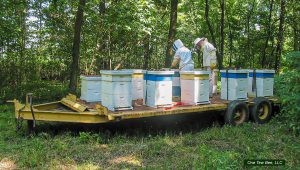
Figure 4. A heavy duty trailer with brakes and a pentel hitch on two axles.
Jim: The two-axle trailer is probably going to have brakes on it, so that really helps. Even a loaded single axle trailer, medium size, 16 feet long with 15, 20, 30 colonies of bees on it, it’s going to really push the truck. You, the driver, must realize that the stopping distance is going to be greatly increased to stop the truck. Double-axle trailers usually have brakes – surge brakes on the tongue – or something like that.
Secondly, those larger trailers are also heavier making it a different concept. More pressure on you the driver and more gas consumption. They are more stable, but there’s a limit on what weight you can put on the bumper hitch.
I pulled a trailer, loaded with good junk, all the way from South Alabama to Northeast Ohio. I didn’t notice until I was backing down my home driveway that my bumper had twisted downward on the truck making my bumper position at about a 35-degree angle. The bolts that held the bumper to the truck frame had slipped.
I was home, but I still had a fearful moment there. What if the bumper had come off? It’s a bumper hitch, so the trailer could have come loose from the truck.
Now, having gotten to this point, I have not routinely used a gooseneck. I’m going to have to depend on you. We’ve used horse trailers and made them work for moving the equipment primarily, but I never used a gooseneck trailer of any kind for moving hives. It was always a bumper hitch or a heavy-duty pentel hitch. You tell me what was involved when hooking up that gooseneck to the truck. You said it was more stable, easier to back. How difficult was it to attach a gooseneck trailer to the truck?
Jeff: It’s a much more stable ride in the wind. That trailer attached as a gooseneck is a much more secure trailer. Backing was a lot easier. It’s more natural, more intuitive, when backing. Even lining up the hitch and hooking it up was easier because, in most cases, you could see it up to the final second to the hitch the trailer in the middle of the truck bed. I understand some of the new trucks now even have a camera looking at the center of the bed of the truck. Even lining it up with a camera is just like many cars now with a backup assist. The downside is that these trailers are more expensive.
Jim: Jeff, I’ve got a question that I guess I’ll check out after we finish this conversation, but right now, can you tell me, what’s the different between a trailer and a wagon?
Jeff: When you say wagon, the only thing I can think of is it says Radio Flyer stamped on the side, or it’s being towed behind a tractor loaded full of hay.
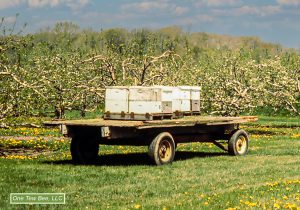
Figure 5. Pollination hives on a hay wagon. This was not a suitable trailer for the open road.
Jim: That’s exactly where I was going. Years ago, I thought I had a bright idea. I took some of the university hay wagons – they’re just very utilitarian devices – and put pollination hives on them. I nailed the pallets and the bottom boards to the deck of the trailer and then put the colony components on the nailed bottom boards. It really made a secure ride. These hives are staying on that trailer. All I had to do was keep the outer covers on.
What’s fundamentally wrong with this? Answer? By the time I got where I was going, I had a load of the angriest, most upset bees you’ve ever seen, and I realized on the trip that you can only go about 20 miles per hour. A hay wagon has no suspension system on it. It’s a slow wagon with a rough ride.
I’m hypothesizing that the difference between a trailer and a wagon is the suspension system, or the lack of it. If anybody has any interest in using a hay wagon, you’re going to have to go at 15-20 miles per hour. If you go much faster, you’re going to be bouncing bees all over the community because there’s not enough weight to settle the trailer out – even if you run the tire’s half slack. That hay wagon idea blew up on me. I was not able to use those simple farm wagons as a bee-moving device on the highway. They work fine within the orchard.
Jeff: Interesting.
Jim: When you mentioned the horse wagon a bit ago, the horse trailer, you wandered into a different arena. Those are enclosed trailers. Cargo doors close them up. I had a shock years ago using a cargo truck (not a trailer) with fold-down doors. I want to tell you it’s really easy, even when the temperature outside was in the 20’s, to overheat that load of bees in an enclosed container.
You’re bouncing them, you’re jostling them, they’re upset, they’re confined. They’ll begin to get worked up and generate heat. It was shocking to have those colonies overheat when the outside temperature was so cold. Now, as I said, that was not a trailer, but an enclosed box truck. Though it’d be the same situation with an enclosed trailer.
My situation was laughable. I had to stop at one of those all-night food stores and buy all the ice they had. While it was frigid outside, I had to put ice on those colonies to calm them down. If you use an enclosed trailer, even on a cold day, you can still overheat the colonies and suffocate them because of the jostling effect that they’re going through with all of that.
Jeff: Not to go off on this tangent but that story reminds me of the time I was in Georgia, and I did a couple of articles on Wilbanks Apiaries. I was doing an article for Bee Culture, and I was talking to the owner. He showed me around his queen-rearing facility. Of course, he does a lot of packages and he had specially designed trailers for moving packages of bees. They were temperature controlled. He can control the temperature inside that enclosed trailer for his bees, which was an interesting concept, but addresses the concern or issues that you faced.
Jim: The reason I’m on this tangent is because of the same thing. A fellow beekeeper here, who contract-hauls packages every Spring, has an environmentally controlled trailer with doors, fans, vents and thermocouples, because he basically says the load is critical. You can insure the trailer, and you can insure the truck, and carry medical insurance – but you can’t insure the live bees. If you overheat those bee packages, that’s a disaster. In his enclosed trailer he’s towing, he knows exactly what’s happening, temperature-wise, from the cab of his truck.
Jeff: That’s smart. Speaking of enclosed trailers, one of the things that I think you’ve seen, and all beekeepers have seen these days, some people and especially in Europe, they are using trailers and AZ-type hives to move bees around.
Jim: Isn’t that interesting. I’ve only seen pictures of that.
Jeff: I look at that and what I know of AZ hives, I think, boy, that would be really a great way of doing things. I still to this day like the idea of putting beehives on a trailer to make my life easier as a beekeeper, a better beekeeper, and the AZ hives could be a good way to go. Putting all of that into a trailer would be fantastic.
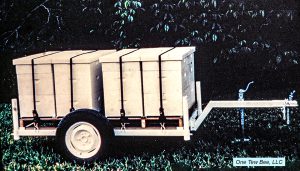
Figure 6. A custom trailer, with a detachable deck, designed to haul eight hives.
Jim: I want to go a little bit deeper down this rabbit hole that you’ve started. [laughter] About sixty years ago, a USDA researcher designed a trailer that allowed the platform bed to be jacked up and taken off the mobile trailer frame. You put four legs down on each corner of the platform, jack the platform up, and raised the platform, with the hives, off the mobile frame of the trailer. Then pull that frame out from under the platform and off you go. You took this strange looking, partial trailer-frame behind you leaving the platform and the hives at the cucumber field.
Jeff: That’s like the container trailers that we see in the Pacific Northwest all the time. I’m sure they’re everywhere. You see those without the container on them. It’s just a frame with wheels.
Jim: Yes.
Jeff: I like that idea.
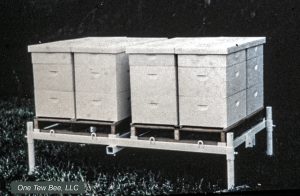
Figure 7. Platform unloaded from the trailer frame.
Jim: Let me tell you where it went. Let me tell you [laughter] why the researcher said you don’t see such bee trailers. When you’re going back to get your platform and its night and the truck’s slipping, everything must be lined up exactly straight. If the mobile frame strikes either one of those back legs, the platform dumps the colonies off the bed.
Jeff: Oh my gosh!
Jim: This very event happened and about 40 colonies either shifted or fell from the trailer deck. He had some pictures of that 40-colony load of bees on that platform, tilted to one side where he accidentally struck one of the back legs. He decided the risk was too great. The idea died.
Now there’s a Chapter Two to this saga. Years ago, I gave this same description to a beekeeping audience. To me, the audience is all beekeepers, but in reality, they’re candlestick makers, soldiers, and sometimes even airline pilots. My point is that they are a blend of people with a myriad of talents. I didn’t know I was talking to two professional welders. From my lecture description, they made that very trailer design, but on a much smaller scale. They took the rear wheel hubs from an ancient Oldsmobile Toronado. That was one of the first front-wheel drive cars.
You would lower pipe legs on the corners of the trailer bed and raise the deck off the frame. There’s ways to do that, but I won’t go into it. Then, with the deck picked up, the wheels are off the ground. You pull out a pin, pull the wheel hubs off, put those in the back of the truck. The tongue was also detachable. You put that in the truck, too. Then in theory, you took the two wheels and the tongue back to the home apiary where you had what? Other platforms. Then you hauled eight different colonies somewhere else. This design was for a small bee operation. That’s why I told you a bit ago that I thought the difference between a trailer and a wagon was suspension.
The idea didn’t go anywhere. Not because you knocked out the back legs, but because the ride was so rough that we’re now back to 15 miles an hour again without a suspension system on the trailer. You just about can’t use it to move bees because it’s so rough on the colonies. This idea, this beautiful, professionally made piece of equipment – one of a kind – never developed. It was just another idea for people exploring what beekeepers could do with trailers to keep from having to unload and reload bee hives.
Jeff: Considering the amount of brain power that’s been put into that over the years by various beekeepers, I’m surprised there’s no easy, readily made solution these days.
Jim: I want to finish on this note. If you have a big truck towing a large trailer and you’re on a narrow country road getting to a beeyard, you better be crystal clear that that truck will make the turn through the gate that you’ve got to go through to get to where you’re going to drop those hives. Because one night, long ago, there was no way – the geometry was all wrong – that I could get my big truck to turn with that long trailer behind it to get through a narrow farmgate.
We had to unhitch the trailer in the road, unload the truck in the out-yard, bring the empty truck back, take the hives off the trailer, load them on the truck, then take the truck to the drop-off site and unload it again. A lot of good it did to have a trailer behind the truck that night. [laughter]
I love trailers. If you don’t have a trailer behind you when you’re moving bees, you’re just not doing your job correctly. Of course, I am kidding. There are quirks to trailering. All trailers have them.
Jeff: I think it comes down to understanding your use of that trailer and your beeyards. Not only can you use that trailer in your beeyard or your multiple beeyards in nice sunny weather, but can you use that trailer in that beeyard on the worst possible days in the dark?
Jim: And do it all by yourself?
Jeff: Yes, by yourself. It’s just that not every yard is on a flat surface. It’s not always going to be on a flat asphalt surface. It’s going to be on an angle, it’s going to be wet, it’s going to be in the mud and the bees are not going to be happy. We haven’t even talked about how do you secure the beehives to the trailer?
Jim: That is a totally different subject. Ratchet straps, hammers, staples. Do not think that the propolis seal will hold that equipment together. Don’t think that the colony will stay together because it’s stuck together with propolis. I have tried that. You’ve got to strap them, but now we’re off the subject. I like trailers, I want to use them for everything. If you use them, they’re going to come with some quirks and caveats, but overall, they give you a broader aspect of beekeeping.
Jeff, I enjoyed chatting with you. Thanks for educating me.
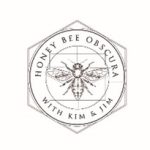 Dr. James E. Tew
Dr. James E. Tew
Emeritus Faculty, Entomology
The Ohio State University
[email protected]
Co-Host, Honey Bee
Obscura Podcast
www.honeybeeobscura.com
